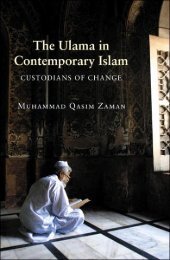The Qur'an in its historical context (pdf - Islam and Christian-Muslim ...
The Qur'an in its historical context (pdf - Islam and Christian-Muslim ...
The Qur'an in its historical context (pdf - Islam and Christian-Muslim ...
You also want an ePaper? Increase the reach of your titles
YUMPU automatically turns print PDFs into web optimized ePapers that Google loves.
THE THEOLOGICAL CHRISTIAN INFLUENCE<br />
Conclusion<br />
Many other po<strong>in</strong>ts could be evoked that would greatly illum<strong>in</strong>ate the possible<br />
<strong>in</strong>fluence of <strong>Christian</strong>ity on the Qur’an: the name of God al-Rahman; the expression<br />
Sibghat Allah (2:138) over which the commentators stumble, the parallels<br />
between Jesus <strong>and</strong> the angels, <strong>and</strong> so on.<br />
Qur’anic proper names that reflect <strong>and</strong> a written<br />
Arabic <strong>Christian</strong> text<br />
Yet what seems even more significant to me are certa<strong>in</strong> proper names that reflect<br />
a written <strong>Christian</strong> text.<br />
a Accord<strong>in</strong>g to Qur’an 61:6 Christ announces a prophet who will come after<br />
him <strong>and</strong> gives him the name Ahmad. In the face of <strong>Christian</strong> objections that<br />
they know no such prophet, <strong>Muslim</strong> tradition sought to expla<strong>in</strong> this verse<br />
accord<strong>in</strong>g to the theme of the Paraclete, the Consoler, which is found three<br />
times <strong>in</strong> the Gospel of John. This <strong>in</strong>terpretation is found already <strong>in</strong> the early<br />
<strong>Muslim</strong>–<strong>Christian</strong> debates, such as that between Timothy (d. 823) <strong>and</strong> the<br />
caliph al-Mahdi <strong>in</strong> 164/781 (r. 158/775–169/785). In the Sira of Ibn Hisham<br />
(d. 218/833) we f<strong>in</strong>d the passages of John on the Paraclete cited, accord<strong>in</strong>g<br />
to the Syro-Palestianian version, which he transliterates as . <strong>The</strong> graphic<br />
likeness of this to (<strong>in</strong> the accusative) probably served to re<strong>in</strong>force this<br />
<strong>in</strong>terpretation.<br />
b <strong>The</strong> Qur’anic name John the Baptist ( ) is evidently a read<strong>in</strong>g of<br />
(a form attested among <strong>Christian</strong> Arabs at least until the tenth century).<br />
c <strong>The</strong> Qur’anic name of the prophet Isaiah , is evidently a read<strong>in</strong>g of<br />
(Sha‘ya), still pronounced this way by <strong>Christian</strong> Arabs today.<br />
<strong>The</strong> Qur’an’s faithfulness to <strong>its</strong> <strong>Christian</strong> sources<br />
As I said <strong>in</strong> the Introduction, one can detect <strong>Christian</strong> <strong>in</strong>fluences <strong>in</strong> the Qur’an <strong>in</strong><br />
<strong>its</strong> narrative aspects: the narratives of the <strong>in</strong>fancy of Mary, the annunciation of<br />
John the Baptist, the annunciation to Mary, the <strong>in</strong>fancy miracles of Jesus, <strong>and</strong> so<br />
on. <strong>The</strong> majority of these texts stem from the apocryphal <strong>in</strong>fancy Gospels, some<br />
of them from the canonical Gospels.<br />
With all of these parallel texts, one is struck by the faithfulness of the Qur’an<br />
to <strong>its</strong> source. One usually has the sense that the author of the Qur’an (I beg<strong>in</strong><br />
with the hypothesis that this religious document has a human author) seeks to<br />
reproduce that which he has gathered as faithfully as possible, sometimes without<br />
underst<strong>and</strong><strong>in</strong>g it, or at least while underst<strong>and</strong><strong>in</strong>g it <strong>in</strong> his own manner. This is<br />
evident <strong>in</strong> regard to the Holy Spirit (Ruh al-Qudus), of Christ the Word of God,<br />
of his conception without human <strong>in</strong>tervention, or the fact that Christ created<br />
liv<strong>in</strong>g th<strong>in</strong>gs (by shap<strong>in</strong>g them <strong>and</strong> breath<strong>in</strong>g <strong>in</strong>to them), <strong>and</strong> so on.<br />
159



